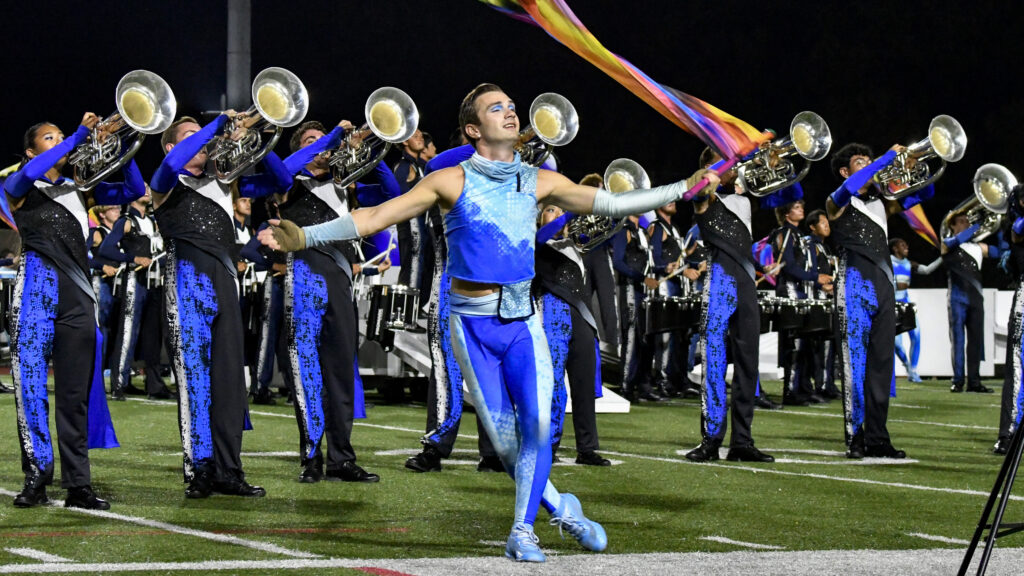If you wanted to find parallels between Phantom Regiment’s 2011 and 2012 production, it wouldn’t be that hard.
Brass, percussion and drum major uniforms looked almost exactly the same, unless you squinted. In both iterations, the brass arrangements were strong, emotional and passionate, with punchy and aggressive percussion writing to back it up. In both years, a love story was at play as the shows’ central storylines.
The crossover characteristics weren’t entirely unintentional. 2011 was a successful year for the Rockford corps, and a competitive step forward from the two previous seasons. Packaging a similar formula for 2012 made all the sense in the world.
“We certainly didn’t want to try to recreate what we had done, because that’s never going to be a success,” visual designer Jamey Thompson said in a 2012 preseason interview. “But we did want to offer the same kinds of things, emotions, excitement to people that we did, in, hopefully, a new, interesting and different way.”
Similarities were apparent. But they weren’t everything. Many of 2012’s differences — some minor and some major, both in scope and musical key — were what made it special.
“It’s another love story,” said Luis Cardénas Casillas, Regiment’s 2012 horn sergeant. “But with a different twist from last year’s show. Last year is that classic, timeless love story of two people that are completely in love with each other. But this year, it’s a story with more grit to it.”


2012 Phantom Regiment | “Turandot”
3rd Place • 96.550
Head to toe, Phantom Regiment’s 2012 corps uniform was almost a replica of its 2011 version. It featured a white helmet with black, flowing plume, a white jacket with black gauntlets and three black, chevron-shaped stripes on the left sleeve, white pants and white shoes.
It was almost a replica. The uniform’s only difference was featured dead center. For 2011’s production, the chest of the corps’ jacket displayed an eagle-like crest. 2012’s edition replaced said crest with a round, symmetrical shape.
According to program coordinator Dan Farrell, this insignia was meant to look like a Chinese coin; Puccini’s “Turandot” drew its inspiration from Chinese music and culture, with much of its music based directly on traditional Chinese anthems.
“We just thought a small nod to what it is that we’re up to would help portray the Chinese identity,” he said.
Color guard members opened the show in red and gold from costumes that resembled the look of a Chinese warrior, with broad shoulders and a spiked, gold headdress.

According to Farrell, the “Turandot” story itself may not have been the most well-known, but it was rather simple to digest. In order to fit a full two-hour, three-act opera into a 12-minute drum corps show, simplifying was the way to go.
“Generally speaking, the story goes that princess Turandot is known as the ice princess; she’s not the kindest person in the world,” he said. “The law of the land is that, if you want to marry princess Turnadot, you have to answer three riddles correctly. And if you don’t, it’s off with your head.”
As the story unfolds, the heart of the “ice princess” is softened by a man named Calàf, who successfully completes the challenge and earns Turandot’s love in the process.
“This year, there’s a very specific storyline, and it’s not a story people know as well,” Thompson added. “So, it has to be very carefully told. What I’m trying to do is create something that has exciting drum corps-style drill, that is also staging these events that tell the story of Turandot and Prince Calàf.”
But before any of that could happen, there had to be bloodshed; it certainly wasn’t the first time for the Rockford corps, which had displayed on-field “death scenes” in several of its previous productions, including 2008 and 2011.
For Regiment’s retelling of “Turnandot”, that came about two minutes in, as the opening moments portrayed the opera’s first act, in which an initial suitor, the Prince of Persia, asserts his attempt at Turandot’s riddles, only to fail and suffer the known consequences.
To properly depict said demise, Phantom Regiment utilized illusion; two conductors, in black, led a corps member to a stone wall prop near the back of the field at the 50-yard-line, pretended to place said members’ head through a hole in the wall, and “chopped off” a white corps helmet, which was filled with blood-red streamers.

After Regiment’s up-tempo opening movement, which lasted about four minutes, music transitioned into a pretty and flowing ballad, which introduced the show’s main character — perceivably, princess Turandot — a solo dancer from the corps’ color guard. Drill design matched the music’s tone well, featuring softer and slower asymmetrical forms, seeming to represent in some way the first riddle’s correct answer — ”hope.”
Reprieve from the Rockford corps’ high-demand visual package didn’t last long, though, as the emotional second movement quickly transitioned into an aggressive percussion feature.
Whether it was the full intent or not, this in-your-face, percussive movement seemed to package the much darker answer of the second riddle — which, of course, the opera’s protagonist again answered correctly — ”blood.”
The next several minutes of the show generally carried a similar tone and tempo — aggressive, energetic and rigid. But ultimately, as the story goes, Calàf answers the third riddle correctly — What is like ice but burns, and if it accepts you as a slave, makes you a king? “Turandot.” He then presents Turandot with his own challenge, to learn and remember his name. She, too, successfully completes this task, and the two finally experience love for one another.
In this pivotal and unifying part of the story, color guard members, in unison, shed their intimidating, red outer garments to reveal a white and turquoise sparkled dress underneath at the center of the field. To match the stunning visual effect, triumphantly, some of the show’s first and strongest major tones were loudly presented.
With the story’s celebratory climactic moment complete and Turandot’s three riddles correctly answered, Phantom Regiment wrapped up its love story the only way it could, with a beautiful arrangement of the opera’s, arguably, most iconic piece, “Nessun Dorma.”
The closing movement began with a beautiful flugelhorn soloist, supported by soft brass chords played to the backfield. As dynamics grew louder and music grew stronger, the arrangement built toward a full-corps turnaround and presentation of the recognizable melody, but the payoff hadn’t quite yet arrived.
There was even further power left for Regiment to build, and build it did. A company front, featuring three rows of brass with percussion behind, led the visual focus toward the center of the field, where the brass members’ formation ended up morphing into the corps’ iconic chevron logo, with a kick-halt and extra-loud brass punch to boot.
Said chord cut off into one more brief solo moment from the same flugelhorn player. The tempo increased, and Phantom Regiment’s triumphant closer raced toward its emotional ending.
Symmetrical drill left an open path down the middle of the field for the show’s two main characters, Turnadot and Calàf, to run toward the drum major podium hand in hand and display their newfound love in conjunction with the show’s strong final chords.
If that visual layout seemed familiar, it’s because it was. The final moments of Regiment’s “Juliet” in 2011 were, visually, presented the same way; drill movements on either side of the 50-yard-line left an open space at midfield for audience members to clearly see Romeo’s dying moments, Juliet’s dismay, and her flight to the conductor’s podium to ultimately portray her character’s own death.
But this time, the overwhelming feeling wasn’t the sorrow and heartbreak of the iconic “Romeo and Juliet” tale.
Vividly on display within the music, the story, and the faces of the front-and-center main characters, it was joy.

Racing for Medals
2012 currently stands as Phantom Regiment’s highest finish since its 2008 championship season, and its most recent time earning medalist status; the Rockford corps earned a bronze medal at season’s end.
For a large chunk of the summer, though, Regiment held fourth place in the overall leaderboard. At an early meeting with The Cadets — who finished the summer in fourth — Regiment scored 0.90 points back. The two didn’t meet again until mid-July; The Cadets won another four head-to-head meetings in a row, in the span of a week, all by slim margins.
July 20 in Houston, Texas, Phantom Regiment jumped ahead of the Allentown corps by 0.20 points. The Cadets regained an edge of 0.15, July 28 in Atlanta, Georgia, and ultimately entered the DCI World Championships with a lead of just five hundredths of a point in what had developed into a race for bronze.
Once competition arrived in the Circle City, though, Phantom Regiment went three-for-three, and ended up with a strong lead of 1.5 points in Finals, earning the bronze medal with room to spare.
The Rockford corps’ strength was its visual package; Regiment scored second overall in visual analysis and color guard, and scored just 0.05 points behind Carolina Crown for second place in the total visual caption.





